c++12_-_stl_container
- 格式:ppt
- 大小:1.31 MB
- 文档页数:76
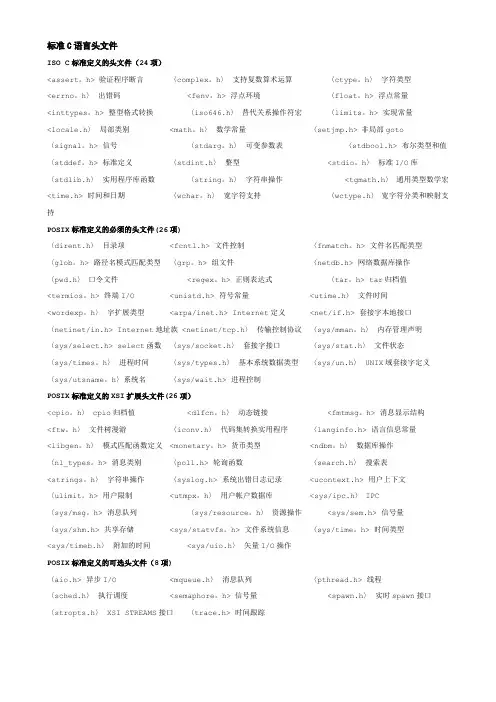
标准C语言头文件ISO C标准定义的头文件(24项)<assert。
h> 验证程序断言〈complex。
h〉支持复数算术运算〈ctype。
h〉字符类型<errno。
h〉出错码<fenv。
h> 浮点环境〈float。
h> 浮点常量<inttypes。
h> 整型格式转换〈iso646.h〉替代关系操作符宏〈limits。
h> 实现常量<locale.h〉局部类别<math。
h〉数学常量〈setjmp.h> 非局部goto〈signal。
h> 信号〈stdarg。
h〉可变参数表〈stdbool.h> 布尔类型和值〈stddef。
h> 标准定义〈stdint.h〉整型<stdio。
h〉标准I/O库〈stdlib.h〉实用程序库函数〈string。
h〉字符串操作<tgmath.h〉通用类型数学宏<time.h> 时间和日期〈wchar。
h〉宽字符支持〈wctype.h〉宽字符分类和映射支持POSIX标准定义的必须的头文件(26项)〈dirent.h〉目录项<fcntl.h> 文件控制〈fnmatch。
h> 文件名匹配类型〈glob。
h> 路径名模式匹配类型〈grp。
h> 组文件〈netdb.h> 网络数据库操作〈pwd.h〉口令文件<regex。
h> 正则表达式〈tar。
h> tar归档值<termios。
h> 终端I/O <unistd.h> 符号常量<utime.h〉文件时间<wordexp。
h〉字扩展类型<arpa/inet.h> Internet定义<net/if.h> 套接字本地接口〈netinet/in.h> Internet地址族 <netinet/tcp.h〉传输控制协议〈sys/mman。
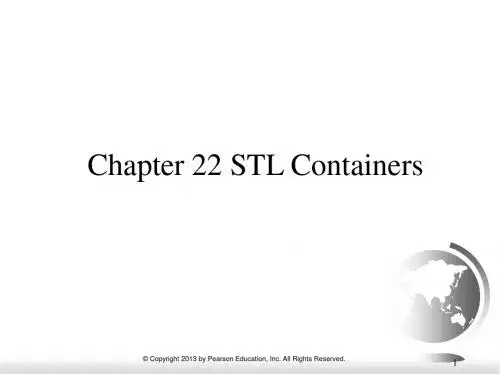
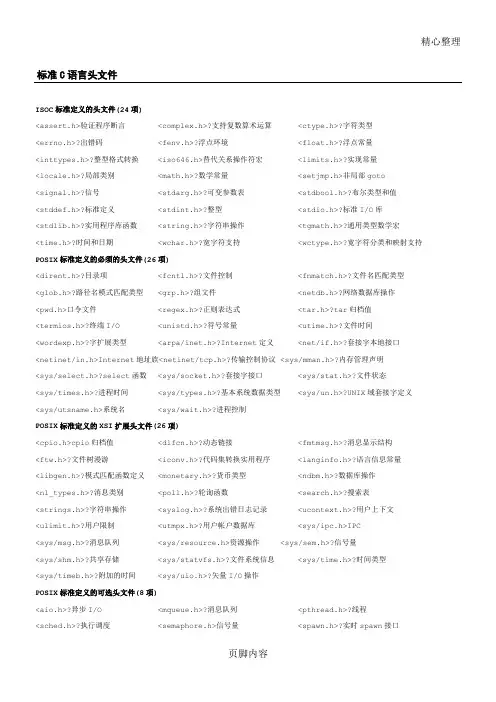
精心整理标准C语言头文件ISOC标准定义的头文件(24项)<assert.h>验证程序断言<complex.h>?支持复数算术运算<ctype.h>?字符类型<errno.h>?出错码<fenv.h>?浮点环境<float.h>?浮点常量<inttypes.h>?整型格式转换<iso646.h>替代关系操作符宏<limits.h>?实现常量<locale.h>?局部类别<math.h>?数学常量<setjmp.h>非局部goto<signal.h>?信号<stdarg.h>?可变参数表<stdbool.h>?布尔类型和值POSIX<pwd.h>POSIX<ftw.h>?<strings.h>?字符串操作<syslog.h>?系统出错日志记录<ucontext.h>?用户上下文<ulimit.h>?用户限制<utmpx.h>?用户帐户数据库<sys/ipc.h>IPC<sys/msg.h>?消息队列<sys/resource.h>资源操作<sys/sem.h>?信号量<sys/shm.h>?共享存储<sys/statvfs.h>?文件系统信息<sys/time.h>?时间类型<sys/timeb.h>?附加的时间<sys/uio.h>?矢量I/O操作POSIX标准定义的可选头文件(8项)<aio.h>?异步I/O <mqueue.h>?消息队列<pthread.h>?线程<sched.h>?执行调度<semaphore.h>信号量<spawn.h>?实时spawn接口<stropts.h>?XSISTREAMS接口<trace.h>?时间跟踪标准C++语言头文件(54个其中16个用于构建STL,3个为附加非必须)<algorithm>STL通用算法<bitset>STL位集容器<cassert>?用于在程序运行时执行断言<cctype>字符处理<cerrno>错误码<cfloat>?用于测试浮点类型属性<ciso646>?ISO646变体字符集<climits>?测试整数类型属性<clocale>本地化函数<cmath> 数学函数<complex>复数类<csetjmp>?执行非内部的goto语句<csignal>?信号<cstdarg>?访问参数数量变化的函数<cstddef>?用于定义实用的类型和宏<cstdio>输入/输出<cstdlib>杂项函数及内存分配<cstring>字符串<ctime> 时间<cwchar>宽字符处理及输入/输出<cwctype>宽字符分类<deque>STL双端队列容器<exception>异常处理类<fstream>文件流TheStandardC++libraryconsistsof51requiredheaders.Thisimplementationalsoincludesthreeadditional headers,<hash_map>,<hash_set>,and<slist>,notrequiredbytheC++Standard,foratotalof54headers.Ofth ese54headers,16constitutetheStandardTemplateLibrary,orSTL.Theseareindicatedbelowwiththenotatio n<algorithm>--(STL)fordefiningnumeroustemplatesthatimplementusefulalgorithms<bitset> --fordefiningatemplateclassthatadministerssetsofbits<complex> --fordefiningatemplateclassthatsupportscomplexarithmetic<deque>--(STL)fordefiningatemplateclassthatimplementsadequecontainer<exception>--fordefiningseveralfunctionsthatcontrolexceptionhandling<fstream> --fordefiningseveraliostreamstemplateclassesthatmanipulateexteralfiles<functional>--(STL)fordefiningseveraltemplatesthathelpconstructpredicatesfor<ios>defined<list><map><memory><new><queue><set><slist>--(STL)fordefiningatemplateclassthatimplementsasinglylinkedlistcontainer<sstream>--fordefiningseveraliostreamstemplateclassesthatmanipulatestringcontainers<stack>--(STL)fordefiningatemplateclassthatimplementsastackcontainer<stdexcept>--fordefiningseveralclassesusefulforreportingexceptions<streambuf>--fordefiningtemplateclassesthatbufferiostreamsoperations<string> --fordefiningatemplateclassthatimplementsastringcontainer<strstream>--fordefiningseveraliostreamsclassesthatmanipulatein-memorycharactersequences<typeinfo> --fordefiningclasstype_info,theresultofthetypeidoperator<utility>--(STL)fordefiningseveraltemplatesofgeneralutility<valarray> --fordefiningseveralclassesandtemplateclassesthatsupportvalue-orientedarrays<vector>--(STL)fordefiningatemplateclassthatimplementsavectorcontainer新的C标准库<cassert> --forenforcingassertionswhenfunctionsexecute<cctype> --forclassifyingcharacters<cerrno> --fortestingerrorcodesreportedbylibraryfunctions<cfloat> --fortestingfloating-pointtypeproperties<ciso646> --forprogramminginISO646variantcharactersets<climits> --fortestingintegertypeproperties<clocale> --foradaptingtodifferentculturalconventions<cmath> --forcomputingcommonmathematicalfunctions<ctime>旧的C<stdlib.h> --forperformingavarietyofoperations<string.h> --formanipulatingseveralkindsofstrings<time.h> --forconvertingbetweenvarioustimeanddateformats<wchar.h> --formanipulatingwidestreamsandseveralkindsofstrings<wctype.h> --forclassifyingwidecharactersFinally,inthisimplementation,theStandardC++libraryalsoincludesseveralheadersforcompatibilitywi thtraditionalC++libraries:<fstream.h>--fordefiningseveraliostreamstemplateclassesthatmanipulateexteralfiles<iomanip.h>--fordeclaringseveraliostreamsmanipulatorsthattakeanargument<iostream.h>--fordeclaringtheiostreamsobjectsthatmanipulatethestandardstreams<new.h> --fordeclaringseveralfunctionsthatallocateandfreestorage<stl.h> --fordeclaringseveraltemplateclassesthataidmigrationfromolderversions oftheStandardTemplateLibrary。
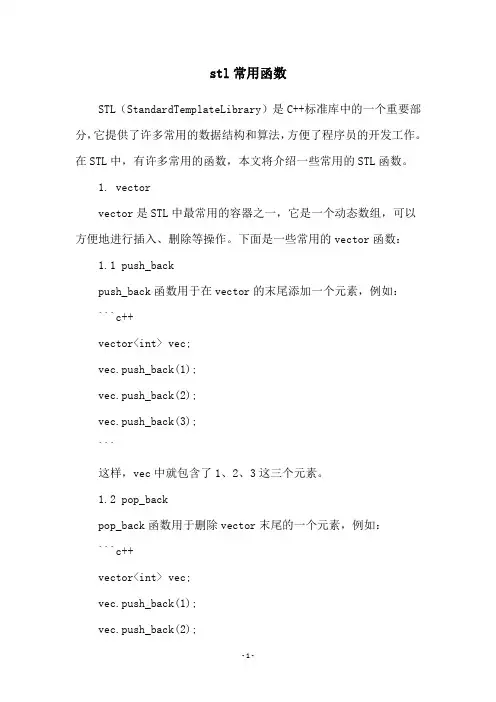
stl常用函数STL(StandardTemplateLibrary)是C++标准库中的一个重要部分,它提供了许多常用的数据结构和算法,方便了程序员的开发工作。
在STL中,有许多常用的函数,本文将介绍一些常用的STL函数。
1. vectorvector是STL中最常用的容器之一,它是一个动态数组,可以方便地进行插入、删除等操作。
下面是一些常用的vector函数:1.1 push_backpush_back函数用于在vector的末尾添加一个元素,例如:```c++vector<int> vec;vec.push_back(1);vec.push_back(2);vec.push_back(3);```这样,vec中就包含了1、2、3这三个元素。
1.2 pop_backpop_back函数用于删除vector末尾的一个元素,例如:```c++vector<int> vec;vec.push_back(1);vec.push_back(2);vec.push_back(3);vec.pop_back();```这样,vec中就只包含了1、2这两个元素。
1.3 sizesize函数用于返回vector中元素的个数,例如: ```c++vector<int> vec;vec.push_back(1);vec.push_back(2);vec.push_back(3);cout << vec.size() << endl;```输出结果为3。
1.4 clearclear函数用于清空vector中的所有元素,例如: ```c++vector<int> vec;vec.push_back(1);vec.push_back(2);vec.push_back(3);vec.clear();```这样,vec就不包含任何元素了。
2. listlist是STL中另一个常用的容器,它是一个双向链表,可以方便地进行插入、删除等操作。
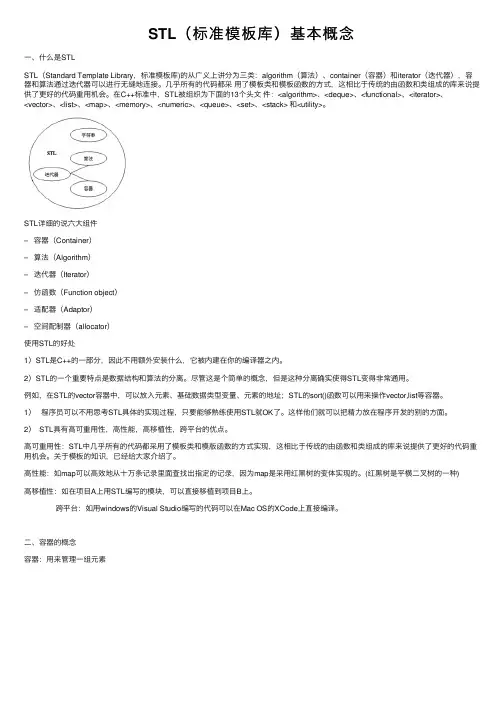
STL(标准模板库)基本概念⼀、什么是STLSTL(Standard Template Library,标准模板库)的从⼴义上讲分为三类:algorithm(算法)、container(容器)和iterator(迭代器),容器和算法通过迭代器可以进⾏⽆缝地连接。
⼏乎所有的代码都采⽤了模板类和模板函数的⽅式,这相⽐于传统的由函数和类组成的库来说提供了更好的代码重⽤机会。
在C++标准中,STL被组织为下⾯的13个头⽂件:<algorithm>、<deque>、<functional>、<iterator>、<vector>、<list>、<map>、<memory>、<numeric>、<queue>、<set>、<stack> 和<utility>。
STL详细的说六⼤组件– 容器(Container)– 算法(Algorithm)– 迭代器(Iterator)– 仿函数(Function object)– 适配器(Adaptor)– 空间配制器(allocator)使⽤STL的好处1)STL是C++的⼀部分,因此不⽤额外安装什么,它被内建在你的编译器之内。
2)STL的⼀个重要特点是数据结构和算法的分离。
尽管这是个简单的概念,但是这种分离确实使得STL变得⾮常通⽤。
例如,在STL的vector容器中,可以放⼊元素、基础数据类型变量、元素的地址;STL的sort()函数可以⽤来操作vector,list等容器。
1)程序员可以不⽤思考STL具体的实现过程,只要能够熟练使⽤STL就OK了。
这样他们就可以把精⼒放在程序开发的别的⽅⾯。
2) STL具有⾼可重⽤性,⾼性能,⾼移植性,跨平台的优点。
⾼可重⽤性:STL中⼏乎所有的代码都采⽤了模板类和模版函数的⽅式实现,这相⽐于传统的由函数和类组成的库来说提供了更好的代码重⽤机会。
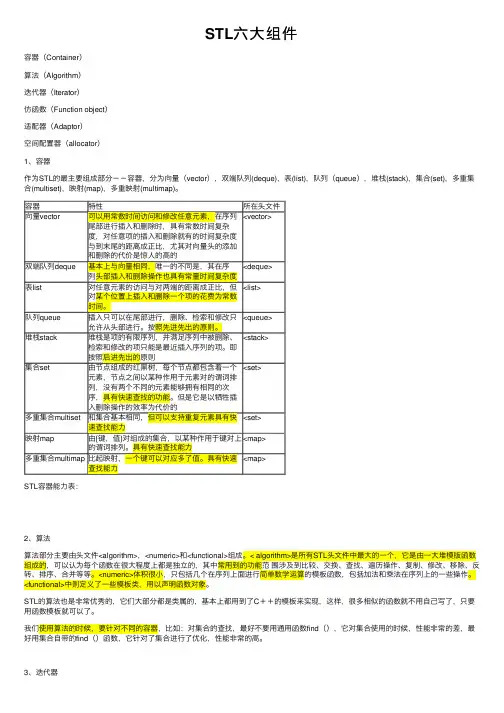
STL六⼤组件容器(Container)算法(Algorithm)迭代器(Iterator)仿函数(Function object)适配器(Adaptor)空间配置器(allocator)1、容器作为STL的最主要组成部分--容器,分为向量(vector),双端队列(deque),表(list),队列(queue),堆栈(stack),集合(set),多重集合(multiset),映射(map),多重映射(multimap)。
容器特性所在头⽂件<vector>向量vector可以⽤常数时间访问和修改任意元素,在序列尾部进⾏插⼊和删除时,具有常数时间复杂度,对任意项的插⼊和删除就有的时间复杂度与到末尾的距离成正⽐,尤其对向量头的添加和删除的代价是惊⼈的⾼的<deque>双端队列deque基本上与向量相同,唯⼀的不同是,其在序列头部插⼊和删除操作也具有常量时间复杂度<list>表list对任意元素的访问与对两端的距离成正⽐,但对某个位置上插⼊和删除⼀个项的花费为常数时间。
<queue>队列queue插⼊只可以在尾部进⾏,删除、检索和修改只允许从头部进⾏。
按照先进先出的原则。
<stack>堆栈stack堆栈是项的有限序列,并满⾜序列中被删除、检索和修改的项只能是最近插⼊序列的项。
即按照后进先出的原则<set>集合set由节点组成的红⿊树,每个节点都包含着⼀个元素,节点之间以某种作⽤于元素对的谓词排列,没有两个不同的元素能够拥有相同的次序,具有快速查找的功能。
但是它是以牺牲插⼊删除操作的效率为代价的<set>多重集合multiset和集合基本相同,但可以⽀持重复元素具有快速查找能⼒<map>映射map由{键,值}对组成的集合,以某种作⽤于键对上的谓词排列。
具有快速查找能⼒<map>多重集合multimap⽐起映射,⼀个键可以对应多了值。
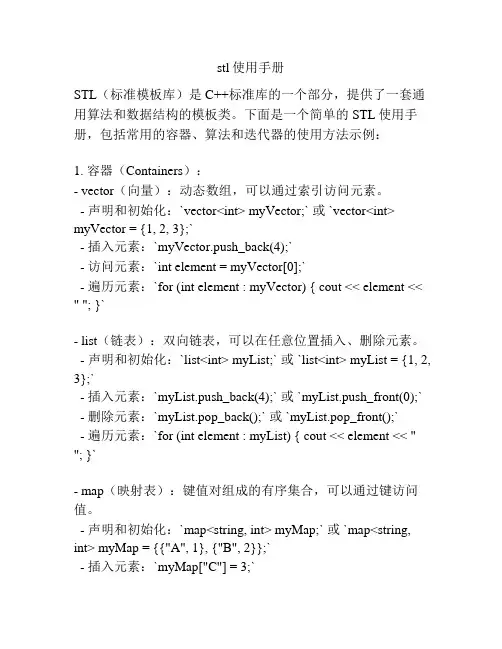
stl使用手册STL(标准模板库)是C++标准库的一个部分,提供了一套通用算法和数据结构的模板类。
下面是一个简单的STL使用手册,包括常用的容器、算法和迭代器的使用方法示例:1. 容器(Containers):- vector(向量):动态数组,可以通过索引访问元素。
- 声明和初始化:`vector<int> myVector;` 或 `vector<int> myVector = {1, 2, 3};`- 插入元素:`myVector.push_back(4);`- 访问元素:`int element = myVector[0];`- 遍历元素:`for (int element : myVector) { cout << element << " "; }`- list(链表):双向链表,可以在任意位置插入、删除元素。
- 声明和初始化:`list<int> myList;` 或 `list<int> myList = {1, 2, 3};`- 插入元素:`myList.push_back(4);` 或 `myList.push_front(0);` - 删除元素:`myList.pop_back();` 或 `myList.pop_front();`- 遍历元素:`for (int element : myList) { cout << element << " "; }`- map(映射表):键值对组成的有序集合,可以通过键访问值。
- 声明和初始化:`map<string, int> myMap;` 或 `map<string, int> myMap = {{"A", 1}, {"B", 2}};`- 插入元素:`myMap["C"] = 3;`- 访问元素:`int value = myMap["A"];`- 遍历元素:`for (pair<string, int> element : myMap) { cout << element.first << ":" << element.second << " "; }`- set(集合):不重复元素的有序集合。
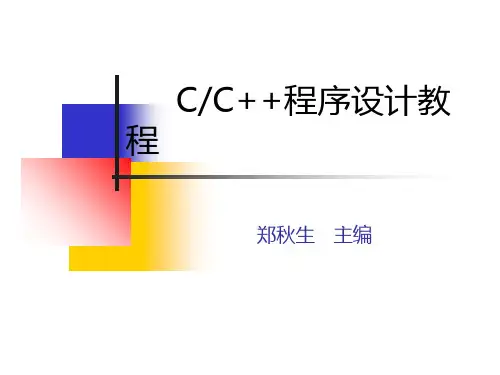
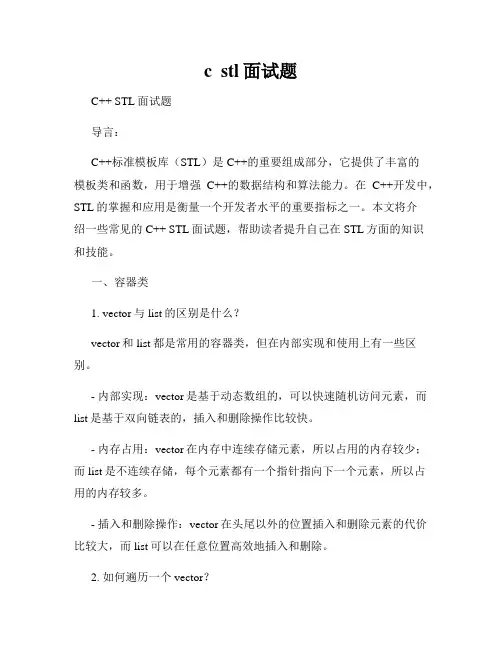
c stl面试题C++ STL面试题导言:C++标准模板库(STL)是C++的重要组成部分,它提供了丰富的模板类和函数,用于增强C++的数据结构和算法能力。
在C++开发中,STL的掌握和应用是衡量一个开发者水平的重要指标之一。
本文将介绍一些常见的C++ STL面试题,帮助读者提升自己在STL方面的知识和技能。
一、容器类1. vector与list的区别是什么?vector和list都是常用的容器类,但在内部实现和使用上有一些区别。
- 内部实现:vector是基于动态数组的,可以快速随机访问元素,而list是基于双向链表的,插入和删除操作比较快。
- 内存占用:vector在内存中连续存储元素,所以占用的内存较少;而list是不连续存储,每个元素都有一个指针指向下一个元素,所以占用的内存较多。
- 插入和删除操作:vector在头尾以外的位置插入和删除元素的代价比较大,而list可以在任意位置高效地插入和删除。
2. 如何遍历一个vector?可以使用迭代器或者基于范围的for循环来遍历一个vector。
- 迭代器遍历:```cppstd::vector<int> vec = {1, 2, 3, 4, 5};for (std::vector<int>::iterator it = vec.begin(); it != vec.end(); ++it) { std::cout << *it << " ";}```- 基于范围的for循环:```cppstd::vector<int> vec = {1, 2, 3, 4, 5};for (const auto& num : vec) {std::cout << num << " ";}```3. 如何在vector中查找指定元素?可以使用`std::find`函数来在vector中查找指定元素。

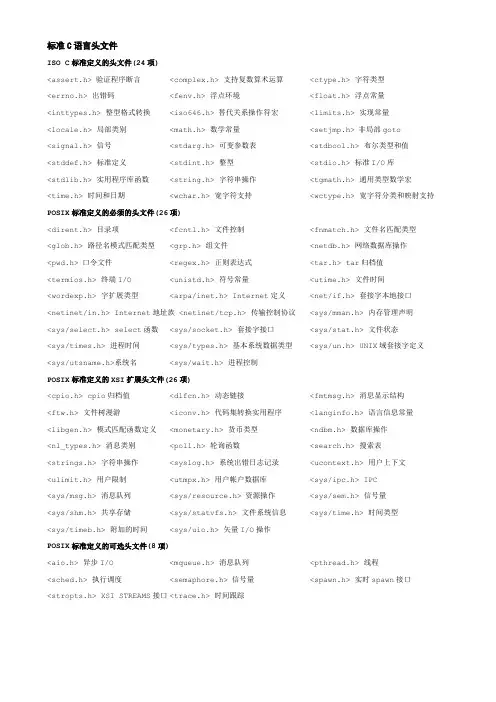
标准C语言头文件ISO C标准定义的头文件(24项)<assert.h> 验证程序断言<complex.h> 支持复数算术运算<ctype.h> 字符类型<errno.h> 出错码<fenv.h> 浮点环境<float.h> 浮点常量<inttypes.h> 整型格式转换<iso646.h> 替代关系操作符宏<limits.h> 实现常量<locale.h> 局部类别<math.h> 数学常量<setjmp.h> 非局部goto<signal.h> 信号<stdarg.h> 可变参数表<stdbool.h> 布尔类型和值<stddef.h> 标准定义<stdint.h> 整型<stdio.h> 标准I/O库<stdlib.h> 实用程序库函数<string.h> 字符串操作<tgmath.h> 通用类型数学宏<time.h> 时间和日期<wchar.h> 宽字符支持<wctype.h> 宽字符分类和映射支持POSIX标准定义的必须的头文件(26项)<dirent.h> 目录项<fcntl.h> 文件控制<fnmatch.h> 文件名匹配类型<glob.h> 路径名模式匹配类型<grp.h> 组文件<netdb.h> 网络数据库操作<pwd.h> 口令文件<regex.h> 正则表达式<tar.h> tar归档值<termios.h> 终端I/O <unistd.h> 符号常量<utime.h> 文件时间<wordexp.h> 字扩展类型<arpa/inet.h> Internet定义<net/if.h> 套接字本地接口<netinet/in.h> Internet地址族 <netinet/tcp.h> 传输控制协议<sys/mman.h> 内存管理声明<sys/select.h> select函数<sys/socket.h> 套接字接口<sys/stat.h> 文件状态<sys/times.h> 进程时间<sys/types.h> 基本系统数据类型<sys/un.h> UNIX域套接字定义<sys/utsname.h>系统名<sys/wait.h> 进程控制POSIX标准定义的XSI扩展头文件(26项)<cpio.h> cpio归档值<dlfcn.h> 动态链接<fmtmsg.h> 消息显示结构<ftw.h> 文件树漫游<iconv.h> 代码集转换实用程序<langinfo.h> 语言信息常量<libgen.h> 模式匹配函数定义<monetary.h> 货币类型<ndbm.h> 数据库操作<nl_types.h> 消息类别<poll.h> 轮询函数<search.h> 搜索表<strings.h> 字符串操作<syslog.h> 系统出错日志记录<ucontext.h> 用户上下文<ulimit.h> 用户限制<utmpx.h> 用户帐户数据库<sys/ipc.h> IPC<sys/msg.h> 消息队列<sys/resource.h> 资源操作<sys/sem.h> 信号量<sys/shm.h> 共享存储<sys/statvfs.h> 文件系统信息<sys/time.h> 时间类型<sys/timeb.h> 附加的时间<sys/uio.h> 矢量I/O操作POSIX标准定义的可选头文件(8项)<aio.h> 异步I/O <mqueue.h> 消息队列<pthread.h> 线程<sched.h> 执行调度<semaphore.h> 信号量<spawn.h> 实时spawn接口<stropts.h> XSI STREAMS接口<trace.h> 时间跟踪标准 C++ 语言头文件(54个其中16个用于构建STL,3个为附加非必须)<algorithm>STL通用算法<bitset> STL位集容器<cassert> 用于在程序运行时执行断言<cctype> 字符处理<cerrno> 错误码<cfloat> 用于测试浮点类型属性<ciso646> ISO646变体字符集<climits> 测试整数类型属性<clocale> 本地化函数<cmath> 数学函数<complex>复数类<csetjmp> 执行非内部的goto语句<csignal> 信号<cstdarg> 访问参数数量变化的函数<cstddef> 用于定义实用的类型和宏<cstdio> 输入/输出<cstdlib> 杂项函数及内存分配<cstring> 字符串<ctime> 时间<cwchar> 宽字符处理及输入/输出<cwctype> 宽字符分类<deque> STL双端队列容器<exception> 异常处理类<fstream> 文件流<functional> STL函数对象<iomanip> 参数化输入/输出<ios>基本输入/输出支持<iosfwd> 输入/输出前置声明<iostream> 数据流输入/输出<istream> 基本输入流<iterator> 遍历序列的类<limits> 各种数据类型最值常量<list>STL线性列表容器<locale> 国际化支持<map> STL映射容器<memory> 专用内存分配器<new> 基本内存分配和释放<numeric> 通用的数字操作<ostream> 基本输出流<queue> STL 队列容器<set> STL 集合容器<sstream> 基于字符串的流<stack> STL 堆栈容器<stdexcept> 标准异常类<streambuf> iostream 的缓冲区类<string> 字符串类<strstream> 非内存字符序列的流类<typeinfo> 运行时类型标识<utility> STL 通用模板类<valarray> 支持值数组的类和模版类<vector> STL 动态数组容器标准C++附加的头文件(3个)非必须<hash_map> <hash_set> <slist>The Standard C++ library consists of 51 required headers.This implementation also includes three additional headers,<hash_map>,<hash_set>,and <slist>,not required by the C++ Standard,for a total of 54 headers.Of these 54 headers,16 constitute the Standard Template Library,or STL.These are indicated below with the notation<algorithm> -- (STL) for defining numerous templates that implement useful algorithms<bitset> -- for defining a template class that administers sets of bits<complex> -- for defining a template class that supports complex arithmetic<deque> -- (STL) for defining a template class that implements a deque container<exception> -- for defining several functions that control exception handling<fstream> -- for defining several iostreams template classes that manipulate exteral files<functional>-- (STL) for defining several templates that help construct predicates for the templates defined in <algorithm> and <numeric><hash_map> -- (STL) for defining template classes that implement hashed associative containersthat map keys to values<hash_set> -- (STL) for defining template classes that implement hashed associative containers<iomanip> -- for declaring several iostreams manipulators that take an argument<ios> -- for defining the template class that serves as the base for many iostreams classes<iosfwd> -- for declaring several iostreams template classes before they are necessarilydefined<iostream> -- for declaring the iostreams objects that manipulate the standard streams<istream> -- for defining the template class that performs extractions<iterator> -- (STL) for defining several templates that help define and manipulate iterators<limits> -- for testing numeric type properties<list>-- (STL) for defining a template class that implements a doubly linked list container<locale> -- for defining several classes and templates that controllocale-specific behavior, as in the iostreams classes<map>-- (STL) for defining template classes that implement associative containers thatmap keys to values<memory>-- (STL) for defining several templates that allocate and free storage for variouscontainer classes<new> -- for declaring several functions that allocate and free storage<numeric>-- (STL) for defining several templates that implement useful numeric functions<ostream> -- for defining the template class that performs insertions<queue> -- (STL) for defining a template class that implements a queue container<set>-- (STL) for defining template classes that implement associative containers<slist>-- (STL) for defining a template class that implements a singly linked list container<sstream> -- for defining several iostreams template classes that manipulate string containers<stack> -- (STL) for defining a template class that implements a stack container<stdexcept> -- for defining several classes useful for reporting exceptions<streambuf> -- for defining template classes that buffer iostreams operations<string> -- for defining a template class that implements a string container<strstream> -- for defining several iostreams classes that manipulate in-memory character sequences<typeinfo> -- for defining class type_info, the result of the typeid operator<utility>-- (STL) for defining several templates of general utility<valarray> -- for defining several classes and template classes that support value-oriented arrays<vector>-- (STL) for defining a template class that implements a vector container新的C标准库<cassert> -- for enforcing assertions when functions execute<cctype> -- for classifying characters<cerrno> -- for testing error codes reported by library functions<cfloat> -- for testing floating-point type properties<ciso646> -- for programming in ISO 646 variant character sets<climits> -- for testing integer type properties<clocale> -- for adapting to different cultural conventions<cmath> -- for computing common mathematical functions<csetjmp> -- for executing nonlocal goto statements<csignal> -- for controlling various exceptional conditions<cstdarg> -- for accessing a varying number of arguments<cstddef> -- for defining several useful types and macros<cstdio> -- for performing input and output<cstdlib> -- for performing a variety of operations<cstring> -- for manipulating several kinds of strings<ctime> -- for converting between various time and date formats<cwchar> -- for manipulating wide streams and several kinds of strings<cwctype> -- for classifying wide characters旧的C标准库<assert.h> -- for enforcing assertions when functions execute<ctype.h> -- for classifying characters<errno.h> -- for testing error codes reported by library functions<float.h> -- for testing floating-point type properties<iso646.h> -- for programming in ISO 646 variant character sets<limits.h> -- for testing integer type properties<locale.h> -- for adapting to different cultural conventions<math.h> -- for computing common mathematical functions<setjmp.h> -- for executing nonlocal goto statements<signal.h> -- for controlling various exceptional conditions<stdarg.h> -- for accessing a varying number of arguments<stddef.h> -- for defining several useful types and macros<stdio.h> -- for performing input and output<stdlib.h> -- for performing a variety of operations<string.h> -- for manipulating several kinds of strings<time.h> -- for converting between various time and date formats<wchar.h> -- for manipulating wide streams and several kinds of strings<wctype.h> -- for classifying wide charactersFinally, in this implementation, the Standard C++ library also includes several headers for compatibility with traditional C++ libraries:<fstream.h> -- for defining several iostreams template classes that manipulate exteral files <iomanip.h> -- for declaring several iostreams manipulators that take an argument<iostream.h> -- for declaring the iostreams objects that manipulate the standard streams <new.h> -- for declaring several functions that allocate and free storage<stl.h> -- for declaring several template classes that aid migration from older versions of the Standard Template Library。
引子STL 主要是为我们提供了丰富的容器和算法,以至于我们在设计程序的时候只用考虑一些更为复杂的结构,比如树状结构,除此之外就是设计的问题。
另外,STL作为一个开放的源码库,良好的泛型结构设计,高效的算法实现都为开发者提供了很好的参考。
但是,正因为STL的灵活性,以及高效性,使得对STL的使用和了解也不算是很容易,我在平时的工作中也深有体会,因此希望能够系统总结一下STL的基本使用方法,以及分析其部分实现,借以提高程序设计能力。
1.什么是STL?1)STL是一套很好的框架,最核心的部件包括:容器,迭代器和算法2)容器包括两大类:a) 序列型:vector, deque, list; b) 关联型:set, multiset, map, multimap3) 迭代器是一个“可遍历STL容器内全部或部分元素的”对象。
按照功能不同可分为五类:input, output, forward, 双向迭代器,随机迭代器。
作用:提供遍历该聚合类型的接口,而不暴露该类型的实现。
2.STL中的容器2.1什么时候使用vectorVector 的特点:1)支持运行时加入新的元素,但是在任意位置插入元素效率较低,因为vector的元素是存放在一段连续的内存中,以提高随机访问的效率。
但如果你需要大量在任意位置插入元素,则最好用List, 因为List采用的链表来管理内部元素。
2)不提供巨大的操作集,如sort(), find(), max(), min(); 而将这些通用的操作交给泛型算法提供。
Vector 中如何存储类类型?2.2 map<string, string>是什么意思?当String作为Key时,map内部是如何计算Key的值的呢?3.STL中的String类4.STL中的迭代器为什么要使用迭代器?在STL中,迭代器属于某一个容器类,比如vector<string>::Iterator iter=vect.begin() 迭代器(Iterator)的实现5.STL中的算法搜索(search):排序(sorting):删除(deletion):算术(numberic):关系(relational):生成(generation):STL应用篇概要STL是泛型编程(Generic Programming,GP)和C++结合的产物。
使用STL指令编程方法STL(Standard Template Library)是C++语言的一种重要的编程库,提供了丰富的数据结构和算法,可以大大提高程序开发的效率和质量。
在这篇文章中,我将介绍如何使用STL指令进行C++编程,讨论STL的常用指令及其用法。
首先,我们需要包含头文件 `<algorithm>`、`<vector>`、`<list>`、`<map>`、`<set>`、`<queue>`等等。
这些头文件包含了STL库的核心组件,提供了大量的类模板和函数模板。
STL的核心组件主要分为三个部分:容器(Containers)、算法(Algorithms)和迭代器(Iterators)。
容器是用于存储数据的类模板,如`vector`、`list`、`map`、`set`等。
算法是对容器中的数据进行各种操作的函数模板,如`sort`、`find`、`count`、`reverse`等。
迭代器是用于遍历容器中的元素的一种智能指针,如`begin`、`end`、`advance`、`iterator`等。
接下来,我们先来看一下容器的使用方法。
以`vector`为例,我们可以通过以下步骤来使用它:1. 声明一个`vector`对象,如`vector<int> nums;`,用于存储整型数据。
2. 使用`push_back`方法向容器中添加元素,如`nums.push_back(1);`、`nums.push_back(2);`等。
3. 使用`size`方法获取容器中的元素个数,如`int size =nums.size(;`。
4. 使用`[]`运算符通过索引访问容器中的元素,如`intfirstElement = nums[0];`。
除了`vector`,STL还提供了其他各种容器,如`list`、`map`、`set`、`stack`、`queue`、`priority_queue`等等,它们分别具有不同的特点和用途。
c++stl使用方法总结C++标准模板库(STL)是C++的一个重要组成部分,提供了许多常用的数据结构和算法。
下面是对C++ STL使用方法的总结:1. 容器(Containers):vector,可变大小的动态数组,使用push_back()添加元素,使用下标访问元素。
list,双向链表,使用push_back()和push_front()添加元素,使用迭代器访问元素。
deque,双端队列,类似于vector,但可以在前后两端高效地添加和删除元素。
set,有序集合,不允许重复元素,使用insert()插入元素,使用迭代器访问元素。
map,有序键值对集合,不允许重复键,使用insert()插入键值对,使用迭代器访问元素。
unordered_set,无序集合,使用哈希表实现,不允许重复元素。
unordered_map,无序键值对集合,使用哈希表实现,不允许重复键。
2. 迭代器(Iterators):迭代器用于遍历容器中的元素,可以使用begin()和end()获取容器的起始和结束迭代器。
迭代器可以使用自增运算符(++)向前遍历容器中的元素,也可以使用解引用运算符()访问迭代器指向的元素。
3. 算法(Algorithms):STL提供了大量的算法,如排序、查找、拷贝、删除等。
使用算法需要包含<algorithm>头文件,例如使用sort()进行排序,使用find()进行查找。
4. 函数对象(Function Objects):函数对象是可调用对象,可以像函数一样使用。
STL提供了一些内置函数对象,如less、greater等,也可以自定义函数对象。
5. 仿函数(Functors):仿函数是一种特殊的函数对象,可以像函数一样使用,可以包含状态。
仿函数可以重载函数调用运算符(operator()),使其可以像函数一样被调用。
6. 算法调用:使用算法时,通常需要提供迭代器作为参数,指定算法的操作范围。
stl用法STL(Standard Template Library)是C++标准库中的一个重要组成部分,它提供了许多数据结构和算法的实现,可以大大简化C++编程的过程。
下面将介绍STL的常用用法,帮助大家更好地应用STL。
一、容器STL中的容器是存储数据的数据结构,在C++中,包括向量(Vector)、链表(List)、双向链表(Deque)、队列(Queue)、栈(Stack)、哈希表(Unordered_map)等多种容器,下面将介绍其中几种容器的常用用法:1. Vector向量是一种可以动态改变大小的数组,它的大小可以根据需要进行改变,通过reserve和resize方法可以分别改变向量的容量和大小,push_back和pop_back方法可以实现在末尾添加和删除元素的操作。
2. List链表是在每个节点中保存指向上一个和下一个节点的指针的数据结构,它的每个元素都包含两个指针,分别指向前一个和后一个节点。
与向量不同的是,链表的大小可以动态扩展,常用的操作包括push_back和push_front方法,可以在链表的尾部和头部添加元素,pop_back和pop_front方法则可以在尾部和头部删除元素。
3. Deque双向链表是一种有序的数据结构,元素的插入和删除操作均可在头部和尾部进行,支持随机访问,且在元素数量大时性能较好。
4. Queue队列是一种先进先出的数据结构,其顺序按照元素添加的顺序进行处理。
队列有两个主要操作: enqueue和dequeue,分别表示在队列的末尾添加元素和在队列的前端删除元素。
5. Stack栈是一种先进后出的数据结构,支持两个基本操作:push和pop,push表示将元素添加到栈顶,pop则表示弹出栈顶元素。
6. Unordered_map哈希表是一种以键值对存储元素的数据结构,与map不同的是,哈希表不会对键进行排序。
哈希表的主要操作包括insert、erase和find 方法,用于添加、删除和查找元素。
C#与STL的容器对应说明(转摘)DotNet下的泛型容器类封装在System.Collections.Generic,使用的十分广泛。
C++则靠STL实现了泛型容器与算法。
下面对二者做一个对比,只谈用法,不深究原理。
对比的内容有数组、链表和字典三种结构。
一、数组C#使用List<T>,C++用的是std::vector<T>,内部实现都是数组,也就是一块连续的内存区域,插入、删除操作慢,随机访问速度快。
二、链表C#使用LinkedList<T>,C++用的是std::list<T>,内部实现都是链表,插入、删除速度快,随机访问速度慢。
链表的操作与数组十分相似,不同的地方大致有:1. 任何通过下标访问的方式都是无效的,查看容量也是无效的,这是由链表的性质决定的。
对链表的查询操作要通过迭代器进行。
也就是说,上表中“查询”、“遍历”的第一种方法、“大小”中的容量都是非法操作。
2. 插入删除的时候也不能指定下标,C++中除了push_back()外,多了一个push_front(),C#中不能使用Add()、Insert(),要使用AddBefore()/AddAfter()/AddFirst()/AddLast()。
3. 排序在C++中直接用list.sort()。
4. std::list<T>要加头文件:#include <list>三、字典C#中使用Dictionary<TKey,TValue>,C++使用std::map<TK,TV>。
map的内部实现是红黑树,Dictionary的实现是哈希表。
DotNet中也有用树实现的字典类结构,叫SortedDictionary,似乎用得不多,效率也没有哈希表高,不过可以保持插入的数据是有序的。
下面的对比是通过字符串来检索整数,为了写起来方便,C++中字符串直接用了LPCTSTR,并且typedef std::map<LPCTSTR,int> map_type;以上便是三种常用的数据结构的用法对比,其实我对这些内容不熟悉,所以有错误的地方请见谅。